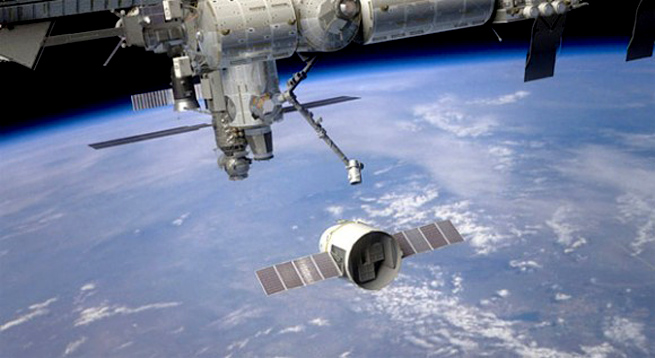 It’s one of the most expensive grocery deliveries in history. And it’s also the first-ever space mission by a private company to re-supply the International Space Station.
It’s one of the most expensive grocery deliveries in history. And it’s also the first-ever space mission by a private company to re-supply the International Space Station.
Carrying over 800 pounds of supplies for the ISS crew — including ice cream for a treat — SpaceX Dragon successfully docked around 4 a.m. PST this morning when Japanese astronaut Akihidko Hoshide secured the spacecraft with the station’s robotic arm.
“Looks like we’ve tamed the Dragon,” NASA expedition commander Sunita Williams said when the arm grabbed the craft. “We’re happy she’s on board with us.”
Capture is confirmed! "Looks like we've tamed the #Dragon" @Astro_Suni http://t.co/CiVii0wl
— SpaceX (@SpaceX) October 10, 2012
This is a historic moment in the history of humanity in space, as it marks the first privately funded and managed spacecraft to launch, carry supplies into orbit, and deliver them to a space station. In one sense, it’s a continuing of NASA’s and other nations’ space agencies exploration of space. In another, it opens a new era of commercialization of space technology and space flight, almost like something out of science-fiction author Ben Bova’s Grand Tour series, with SpaceX founder Elon Musk playing the role of industrialist and explorer Dan Randolph.
Securing the spacecraft is only the first step. The ISS crew now has to dock the ship in the station’s port, the “Common Berthing Mechanism,” from which the astronauts can access the ship and extract the supplies.
Dragon’s flight was not uneventful: One of the spacecraft’s nine rocket engines failed during the launch. However, the craft, which is designed to still launch with only seven operational engines, recalculated a new ascent profile, relieved pressure in the blocked rocket, and successfully reached orbit.
Building a space launch vehicle that can successfully complete missions even when things go wrong is impressive design, and SpaceX says that no other currently operational rockets have the same capability.
In addition, it’s worth noting that, while spaceflight may never be cheap, the cost for SpaceX to deliver supplies and groceries to low-earth orbit are approximately half NASA’s now-shuttered space shuttle. Lifting a kilogram of cargo to low Earth orbit costs Spacex about $5,000; the shuttle burned about $10,000 to accomplish the same feat.
The Dragon will stay at the ISS for an expected two and half weeks and then return to Earth with a cargo from the space station.
VentureBeat's mission is to be a digital town square for technical decision-makers to gain knowledge about transformative enterprise technology and transact. Learn More

